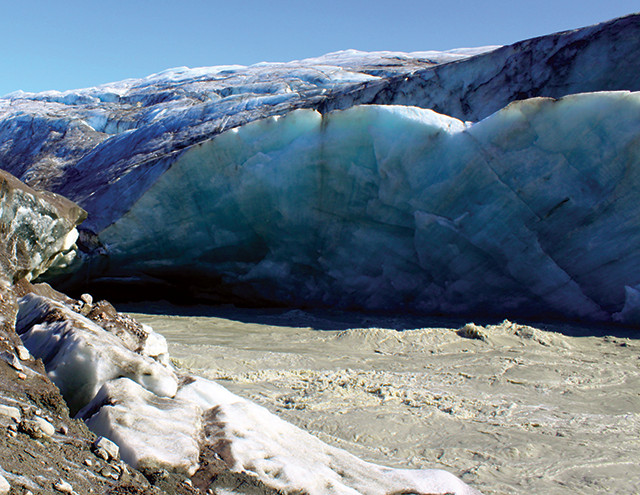
by Timothy Oleson Friday, May 20, 2016

Phosphorus-rich meltwater flows from the Leverett Glacier in southwest Greenland. Credit: Jon Hawkings.
From Antarctica to the Arctic; from polar caps, permafrost and glaciers to ocean-rafted sea ice; and from burly bears to cold-loving microbes, fascinating science is found in every nook and crevasse of Earth’s cryosphere, and new findings are announced often. Here are a few of the latest updates.
Researchers recently found that buoyant warm waters off Antarctica are slicing into the undersides of ice shelves, creating long subsurface channels that may contribute to destabilization of the vast, floating platforms. Ice shelves surround most of Antarctica, buttressing the larger continental ice sheet and slowing its flow toward the ocean. Researchers analyzed satellite imagery and altimetry as well as airborne ice-penetrating radar data collected from 2002 to 2014. They identified numerous channels up to tens of kilometers long, 5 kilometers across and 50 to 250 meters deep in the bases of shelves, which vary in thickness overall from about 100 meters to 2 kilometers. “We found that warm ocean water is carving these ‘upside-down rivers’ … into the undersides of ice shelves all around the Antarctic continent. In at least some cases these channels weaken the ice shelves, making them more vulnerable to disintegration,” said Karen Alley, a graduate student at the University of Colorado at Boulder in a statement. Alley and colleagues reported in Nature Geoscience that the basal channels were most prevalent in shelves off West Antarctica, such as the Getz Ice Shelf, and that they appear to be associated with formation of crevasses on shelf surfaces.
Warming was also likely responsible for the large-scale retreat of Antarctica’s largest ice shelf following the last glacial maximum (LGM), according to a study in Proceedings of the National Academy of Sciences. About 18,000 years ago, the Ross Ice Shelf — which today still covers about 500,000 square kilometers, roughly the size of Spain — extended hundreds of kilometers farther offshore. Scientists led by Yusuke Yokoyama of the University of Tokyo in Japan studied geomorphic evidence of the ice left on the seafloor — like furrows gouged by the deep keels of enormous icebergs that broke free of the shelf and scraped the bottom — as well as isotopes in samples of seafloor sediments from beneath the area formerly covered by the shelf. They found that the western portion of the shelf began breaking up soon after the LGM, but that it stabilized by about 10,000 years ago. Starting about 5,000 years ago, however, a much larger section of the ancestral Ross Ice Shelf, about 280,000 square kilometers, disintegrated before reaching its current state by 1,500 years ago. Modeling of the ice shelf and ocean suggested to the team that warming air and ocean currents combined to cause the breakups of the shelf.
A new study suggests that Greenland’s ice sheet might shed as much phosphorus into the ocean annually — about 400,000 metric tons — as the Mississippi or Amazon rivers. Phosphorus is a vital nutrient for plankton, which sit at the base of the oceanic food chain, so the amount added by massive ice sheets could substantially affect ocean productivity. Although glacial meltwater was known to contain phosphorus, there has been little systematic study of how much is expelled by ice sheets. Jon Hawkings of the University of Bristol in England and colleagues measured meltwater flow rates and collected water samples from two Greenland Ice Sheet glaciers in 2012 and 2013. They reported in the journal Global Biogeochemical Cycles that concentrations of dissolved phosphorus in the meltwater were similar to those seen in Arctic rivers, but that total phosphorus levels were substantially higher due to large quantities of bedrock particles ground up by the glacial ice. Exactly how much of that particulate matter makes it into the oceans and could be used by plankton before the particles settle to the seafloor is not clear. But the team estimated that the Greenland Ice Sheet overall contributes about 15 percent of the bioavailable phosphorus to the Arctic each year.
© 2008-2021. All rights reserved. Any copying, redistribution or retransmission of any of the contents of this service without the expressed written permission of the American Geosciences Institute is expressly prohibited. Click here for all copyright requests.